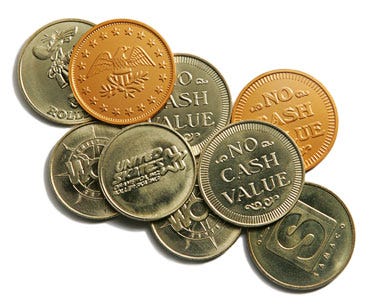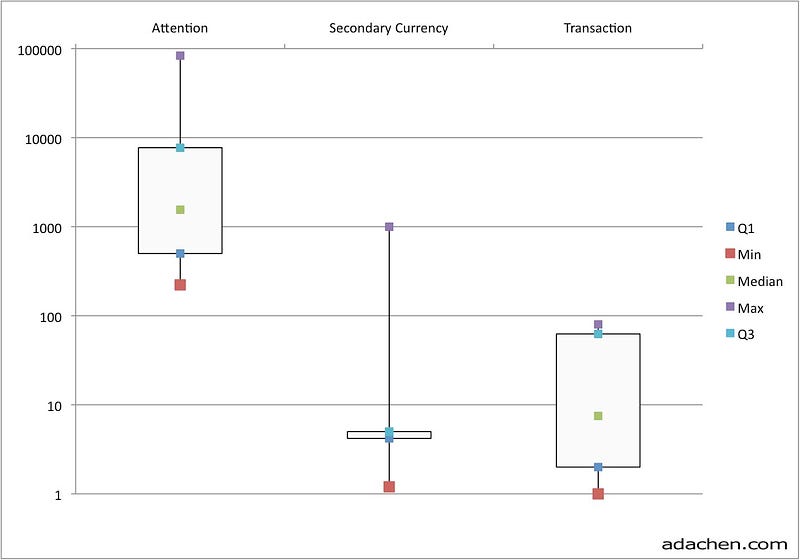
One of the key early decisions to game design or creating a virtual currency platform is designing the price and exchange rate of virtual currency. Unfortunately after it’s been released, it’s also one of the most difficult to change, because the change impacts the userbase and economy of the system as a whole. So if you’re starting out, how do you decide how to price your virtual currency?
Three Types of Virtual Currency
To answer this question, I started by looking across a broad swath of popular social games, social networks, and some MMOs and virtual worlds. Currency is typically used in three different forms across these games:
Attention Currency — currency earned by taking actions on the website and rewarding engagement. For example, Gaia Online’s Gold Pieces are earned by posting in forums and playing in games. This is roughly analogous to currency earned as a function of time.
Secondary Currency — paid currency in addition to attention currency which is tied to cash value. This is typically added as a way to control economic inflation. For example, in Playfish’s Restaurant City you earn both attention currency as coins as well have the ability to buy exclusive items through Playfish Cash.
Transaction Currency — currency tied purely to making transactions that can be used in multiple contexts and often transcends a single application or website. For example, this is Facebook’s Credits system.
Virtual Currency Pricing Today
With data from 57 applications and sites, I attempted to normalize the pricing structure of these games by taking the small cash purchase amount (usually $2-$5) and determining how many units of the virtual currency could be purchased with $1 USD, and then examining the distribution.

Looking across this dataset, it’s clear that attention currencies have a huge range of comparison relative to secondary and transaction currencies. I’d think through some questions first in determining how to price your currency.
- When and how are your users presented with the currency?
- What is the price range of goods which you expect to sell?
- How well should the user understand the value of the currency?
You should consider how to price your currency based on how the customer first sees it. For engagement-oriented attention currency, users are first presented with the currency when they’re earning it as payment for their actions. For secondary and transaction currencies, users first see the currency when they are making a purchase decision and seeing the price. Because of this, attention currencies should probably be on the high range and secondary and transaction currencies should be smaller numbers.
Also, you should make a decision about your currency based on your intended item price range because it sets the minimum and (loosely) maximum price ranges available in your economy.
An example of this was when Facebook adjusted the value of Facebook Credits in May 2009, changing the pricing from $1:100 to $1:10 credits:
We want to make sure that even the smallest amount of credits is meaningful. Now by accumulating as little as 10 credits, you can buy a gift to add more significance to a friend’s birthday, celebrate a special occasion or simply have fun.
At the time, Facebook was running tests on physical goods such as a $50 bouquet gift for a friend’s birthday. Rather than pricing it at 5,000 credits, 500 is much simpler pricing. The credits price also indicates the lowest bound of the smallest transaction you are willing to allow within your ecosystem. With a $1:10 ratio, the smallest transaction Facebook will process is $0.10 instead of $0.01.
Well what about secondary vs transaction currencies? Secondary currencies tend to be tied to virtual goods, which means they can be flexible in their pricing. The games using secondary currencies are largely closed economies without the ability to exchange currency or cash it out. Because of this, 89% of the secondary currencies had incentives to purchase larger currency amounts at a better exchange rate and obfuscating the true price you’re paying for the good.
In comparison, transaction currencies did not offer incentives. Their purpose is to ease payment friction in for small payments across multiple merchants. Since users are purely funding transactional currency to purchase items later across multiple contexts, this type of currency tends to be more straightforward in doing the math with fewer attempts to obfuscate the rates.
Conclusion
Ultimately, I think that you need to heavily consider the context in which a user first becomes aware of the currency, whether earning it or seeing it in the store. Dual currency systems are particularly valuable because items with two prices (free attention currency vs paid secondary currency) sets two contexts to the value the item. The user can either invest their time or money to get the item. You need to consider your long-term pricing structure on what items you plan to sell, and whether or not you allow money to be exchanged or used across multiple properties. And finally, you also need to consider all of this up-front because it can be costly and difficult to reset this after release!
*Appendix: Dataset
Attention Currencies (24): Bowling Buddies, Sorority Life, YoVille Coins, Fishville Coins, Minigolf Party, Restaurant City, Farmville Farm Coins, Happy Aquarium Coins, Poker Rivals Poker Chips, Petville Coins, Happy Island Coins, Tiki Farm Shells, Gangster City Money, Tiki Resort Shells, Treasure Isle Coins, Wild Ones Coins, My Empire Coins, Hotel City Coins, Frontierville Frontier Coins, Pirates! AHOY Coins, Car Town Coins, It Girl, MyYearbook LunchMoney, Bejeweled Blitz (FB)
Secondary Currencies (27): Maplestory, YoVille YoCash, Pet Society, Fishville Sand Dollars, Farmville Farm Cash, Crazy Planets, Country Story, Happy Aquarium Pearls, Treasure Isle Island Cash, Frontierville Horseshoes, Gaia Online Gaia Cash, Car Town, Habbo Coins, gPotato, Dragon Wars, Fashion Wars, Street Racing, Vampire Wars, Friends for Sale, City of Wonder Gold, Social City, Market Street, Wild Ones Treats, Bola Melon Cash, Sorority Life Brownie Points, Millionaire City Gold Bars, Petville Cash
Transaction Currencies (6): hi5, Facebook, Xbox 360 Live, Spare Change, SocialGold, Playfish Cash